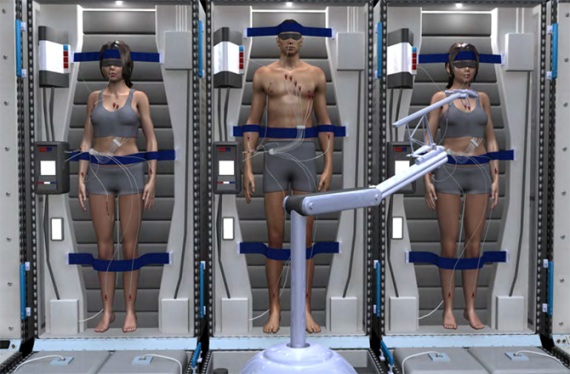Science Fiction of Today – Science Fact of the Not so Distant Future?
I’ve often been fascinated by the remarkable breakthroughs in scientific discovery inspired by science fiction. Fans of Star Trek, which started in the early 1960’s, often point to the ‘everyday’ devices the crew of the Starship Enterprise used, which are now part of our lives.
Hyposprays, sliding doors, handheld communication devices that can span the planet, to name just a few – and don’t forget – the latest breakthroughs in quantum teleportation are pushing the boundaries even further.
Imagine my delight, then, when I saw this little article in Discovery Magazine touching on another aspect of science fiction that may one day soon, be part of science fact.
The Hyper-Sleep.

A NASA-backed study explores an innovative way to dramatically cut the cost of a human expedition to Mars — put the crew in stasis.
During interplanetary transit, the crew would receive low-level electrical impulses to key muscle groups to prevent muscular atrophy.
The deep sleep, called torpor, would reduce astronauts’ metabolic functions with existing medical procedures. (Remember, Torpor also can occur naturally in cases of hypothermia.)
“Therapeutic torpor has been around in theory since the 1980s and really since 2003 has been a staple for critical care trauma patients in hospitals,” said aerospace engineer Mark Schaffer, with SpaceWorks Enterprises in Atlanta. “Protocols exist in most major medical centers for inducing therapeutic hypothermia on patients to essentially keep them alive until they can get the kind of treatment that they need.”
Coupled with intravenous feeding, a crew could be put in hibernation for the transit time to Mars, which under the best-case scenario would take 180 days one-way.
So far, the duration of a patient’s time in torpor state has been limited to about one week.
“We haven’t had the need to keep someone in (therapeutic torpor) for longer than seven days,” Schaffer said. “For human Mars missions, we need to push that to at least ninety days. Those are the types of mission flight times we’re talking about.”
Economically, the payoff looks impressive. Crews can live inside smaller ships with fewer amenities like galleys, exercise gear and of course water, food and clothing. One design includes a spinning habitat to provide a low-gravity environment to help offset bone and muscle loss.
Naturally, there is still plenty of research and development that needs to be done before a torpor hibernation system can be considered a feasible option for space travel. So far, preliminary tests have only been used in therapeutic scenarios here on Earth. The next step will be to test it in orbit.
Luckily, the potential savings during a trip to Mars or somewhere in the outer Solar System could be just the incentive to make it happen. And no matter what, it seems that some form of induced-hibernation will be necessary if humanity is ever to explore the depths of space.
*******
Now, I know what you might be thinking. I’ve watched the likes of 2001 – A Space Odyssey, Alien, Lost in Space, Forbidden Planet, etc, and we’re well used to the concept of people being sent to sleep for much longer periods. But hey! We’ve got to start somewhere. As the report highlighted, future manned missions into deep space will present numerous challenges. In addition to the sheer amount of food, water and air necessary to keep a crew alive for months (or years) at a time, there’s also the question of keeping them sane and functional. So, baby steps are good. We’ll be up and running soon enough.
![alien_hypersleep_chamber[1]](https://amazingstories.com/wp-content/uploads/2014/11/alien_hypersleep_chamber1.jpg)
And what this all emphasizes is the fact that exciting times are just around the corner.
Is it just me, or does anyone else wish they could be born again about a hundred years from now?
Ooooh, if only….
Until the next time, stay well,










